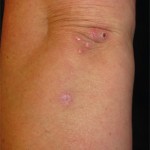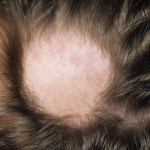Conclusion
Efforts have been made to understand the possible link between hair dyes and inflammatory arthritis. Further research is warranted to address the significance of this issue, especially with respect to the safety of hair dye ingredients. We urge rheumatologists to be aware of the link between hair dyes and inflammatory arthritis. Obtaining a detailed history regarding environmental exposures is crucial in patients with inflammatory diseases.
 Hrudya Abraham, MD, is a rheumatology fellow in the University of Cincinnati Medical Center Division of Immunology, Allergy and Rheumatology.
Hrudya Abraham, MD, is a rheumatology fellow in the University of Cincinnati Medical Center Division of Immunology, Allergy and Rheumatology.
 Eric J. Warm, MD, FACP, is the Richard W. & Sue P. Vilter Professor of Medicine and the program director for internal medicine at the University of Cincinnati Medical Center.
Eric J. Warm, MD, FACP, is the Richard W. & Sue P. Vilter Professor of Medicine and the program director for internal medicine at the University of Cincinnati Medical Center.
 Avis Ware, MD, is a professor of medicine and the director of the Rheumatology Clinic in the University of Cincinnati Medical Center Division of Immunology, Allergy and Rheumatology.
Avis Ware, MD, is a professor of medicine and the director of the Rheumatology Clinic in the University of Cincinnati Medical Center Division of Immunology, Allergy and Rheumatology.
References
- Mukkanna KS, Stone NM, Ingram JR. Para-phenylenediamine allergy: current perspectives on diagnosis and management. J Asthma Allergy. 2017;10:9–15. doi: 10.2147/JAA.S90265
- Hefford B. Colour and controversy. Chemistry World. 2012 Oct 2.
- Hofmann AW. Organische Basen. Jahresberichte ueber die Fortschritte der Chemie. [Annual report of progress in chemistry] 1863;3:422. German.
- Thyssen JP, White JM. European Society of Contact Dermatitis. Epidemiological data on consumer allergy to p-phenylenediamine. Contact Dermatitis. 2008 Dec;59(6):327–343.
- Sharma VK, Sethuraman G, Garg T, et al. Patch testing with the Indian standard series in New Delhi. Contact Dermatitis. 2004 Nov–Dec;51(5–6):319–321.
- Vogel TA, Coenraads PJ, Bijkersma LM, et al. p-Phenylenediamine exposure in real life—a case–control study on sensitization rate, mode and elicitation reactions in the northern Netherlands. Contact Dermatitis. 2015 Jun;72(6):355–361.
- D’Cruz D. Autoimmune diseases associated with drugs, chemicals and environmental factors. Toxicol Lett. 2000 Mar 15;112–113:421–432.
- Fournié GJ, Mas M, Cautain B, Savignac M, et al. Induction of autoimmunity through bystander effects. Lessons from immunological disorders induced by heavy metals. J Autoimmun. 2001 May;16(3):319–326.
- Costenbader KH, Karlson EW. Cigarette smoking and autoimmune disease: What can we learn from epidemiology? Lupus. 2006;15(11):737–745.
- Sugiyama D, Nishimura K, Tamaki K, et al. Impact of smoking as a risk factor for developing rheumatoid arthritis: A meta-analysis of observational studies. Ann Rheum Dis. 2010 Jan;69(1):70–81.
- Cooper GS, Wither J, Bernatsky S, et al. Occupational and environmental exposures and risk of systemic lupus erythematosus: Silica, sunlight, solvents. Rheumatology (Oxford). 2010 Nov;49(11):2172–2180.
- Smyk D, Rigopoulou EI, Bizzaro N, Bogdanos DP. Hair dyes as risk for autoimmunity: From systemic lupus erythematosus to primary biliary cirrhosis. Auto Immun Highlights. 2012 Jan 13;4(1):1–9.
- Price EJ, Venables PJ. Drug-induced lupus. Drug Saf. 1995 Apr;12(4):283–290.
- Reckner Olsson A, Skogh T, Wingren G. Comorbidity and lifestyle, reproductive factors, and environmental exposures associated with rheumatoid arthritis. Ann Rheum Dis. 2001 Oct;60(10):934–939.
- Lundberg I, Alfredsson L, Plato N, et al. Occupation, occupational exposure to chemicals and rheumatological disease. A register based cohort study. Scand J Rheumatol. 1994;23(6):305–310.
- Christen U, Hintermann E, Holdener M, von Herrath MG. Viral triggers for autoimmunity: Is the ‘glass of molecular mimicry’ half full or half empty? J Autoimmun. 2010 Feb;34(1):38–44.
- Alunno A, Bartoloni E, Nocentini G, et al. Role of regulatory T cells in rheumatoid arthritis: Facts and hypothesis. Auto Immun Highlights. 2010 Jul 10;1(1):45–51.
- Rubin IM, Dabelsteen S, Nielsen MM, et al. Repeated exposure to hair dye induces regulatory T cells in mice. Br J Dermatol. 2010 Nov;163(5):992–998.
- Freni-Titulaer LW, Kelley DB, Grow AG, et al. Connective tissue disease in southeastern Georgia: A case-control study of etiologic factors. Am J Epidemiol. 1989 Aug;130(2):404–409.
- Petri M, Allbritton J. Hair product use in systemic lupus erythematosus. A case-control study. Arthritis Rheum. 1992 Jan;35(6):625–629.
- Cooper GS, Dooley MA, Treadwell EL, et al. Smoking and use of hair treatments in relation to risk of developing systemic lupus erythematosus. J Rheumatol. 2001 Dec;28(12):2653–2656.

